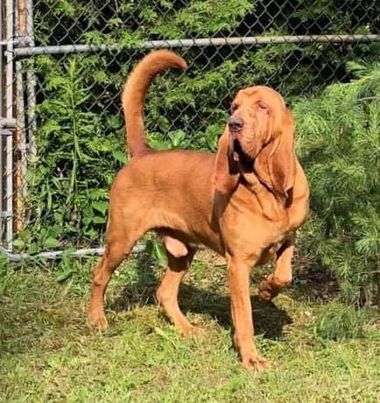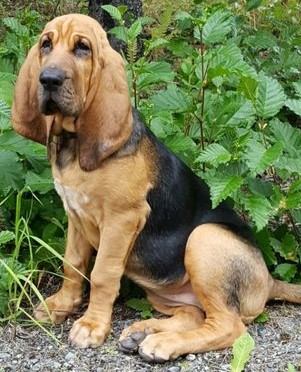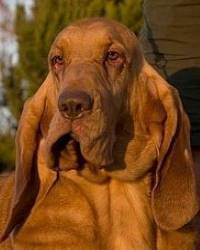History and Origin: The Bloodhound is the oldest of the scent hounds as we know them today. All scent hounds today were bred with the Bloodhound as the base. Although his beginnings are left to speculation, we owe his development to St. Hubert, the patron saint of the hunter. It was believed he originally obtained his stock from southern France. This breeding was carried on after his death by the abbots, who succeeded him. The original purpose of the Bloodhound is not completely clear but, in the time they were bred, hunting had to be uppermost. The nobility of the day soon learned they made excellent trackers of people and were heavily used to trail and find game poachers killing the King’s game. They are fine trackers and today that remains the bloodhound’s primary purpose, along with rescue and cadaver search.
General Appearance: The average height of an adult Bloodhound may be from 23-27 in (58-69 cm) at the shoulder. In good condition, an adult should tip the scales at 80-110 lb (36-49.5 kg).The heavier dog is favoured provided all other attributes are balanced and harmonious. The breed is very powerful with heavy bone. The chest is very deep and forms a keel. The skin is thin and loose, hanging in deep folds about the neck and head. The ears are very long and pendulous. Because of the excess skin and loose lips this breed does drool profusely so care must be taken to keep the mouth clean and dry especially after drinking and when food is available, otherwise with each head shake, you will be washing your walls frequently. Drool towels are a necessity. Please remember that this is a very large breed of dog at maturity.

Coat and Colour: The coat is short and lies flat. Bloodhounds may be black and tan, liver and tan and red. Any other colour is a disqualification. A small amount of white is permitted on the chest, feet and tip of tail. . A weekly rubdown with a bristle brush or hound mitt takes care of the coat and removes dead hair. However, the drooping eyelids and lengthy ears can gather debris and become areas of irritation. Check these areas and all skin folds regularly and clean as necessary
Feeding: The bloodhound puppy will require about 3 meals a day up to the age of six months. Thereafter, the bloodhound should be fed twice daily. He should be fed a quality kibble with a good percentage of protein and adequate fat. Feed at the same time each day and avoid excessive exercise before and after meals. It might be wise to soak the kibble to a softened texture with warm water prior to feeding. And of course fresh water should always be available.
Training and Obedience: As with all breeds, early socialization and puppy training classes are recommended. With a Bloodhound, it is best to start obedience classes early; they tend to become set in their ways, and it’s better if the behaviors they hold onto for a lifetime are the behaviors the owner wants. Bloodhounds like to take charge, so an owner needs to be firm but kind. Training that involves positive rewards, such as treats and praise, is usually effective. The Bloodhound is affectionate and devoted and also stubborn and independent, so his training requires patience, consistency, and skill. He is an amazing tracker and can excel in these types of competition.
Activity: As a scent hound, the Bloodhound is capable of a great deal of endurance and like any good hound, it only takes a whiff of an interesting scent to get him off and running. He has great stamina and can cover a great deal of distance in a short time. Though he adapts well to either city or country living, he requires daily exercise to maintain fitness and an enclosed area if he is off-leash.
Temperament: The Bloodhound is an extremely affectionate dog with a gentle nature. He gets along well with other dogs. He may be somewhat shy and is very sensitive to kindness or corrections by his owner.
.


